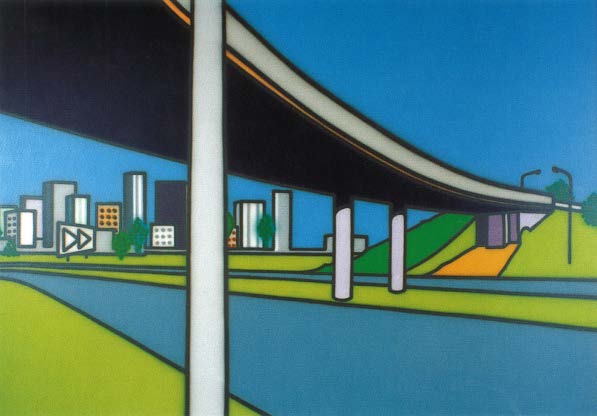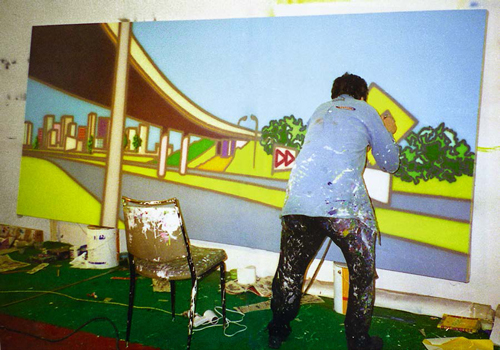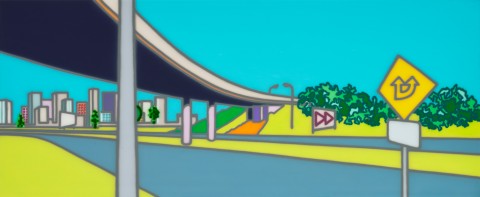The freeway, 1999
Howard Arkley
synthetic polymer paint on canvas
150.0 x 366.0 cm
signed and dated verso: Howard Arkley 99
signed, dated and inscribed with title verso: The Freeway 99 / Howard Arkley 99 / 1999
Roger Wood and Randal Marsh, Melbourne, commissioned directly from the artist in 1999
On the Road: the car in Australian art, Museum of Modern Art at Heide, Melbourne, 11 December 1999 - 19 March 2000
Howard Arkley: The Retrospective, The Ian Potter Centre: NGV Australia at Federation Square, Melbourne, 17 November 2006 - 25 February 2007 (label attached verso, as ‘Freeway’)
Howard Arkley and Friends, TarraWarra Museum of Art, Melbourne, 5 December 2015 – 28 February 2016
Moore, M., 'Howard Arkley', Hemisphere [United Airlines inflight magazine], June 1999, pp. 66 - 67 (illus.)
Gott, T., and Gellatly, K., On the Road: The Car in Australian Art, Museum of Modern Art at Heide, Melbourne, 1999, p. 4 (illus.)
Crawford, A., 'Howard Arkley 1951 - 1999', Art & Australia, vol. 37, no. 3, 2000, p. 376 (illus.)
Gregory, J,. Carnival in Suburbia, The Art of Howard Arkley, Cambridge University Press, Melbourne, 2006, fig. 1.31, pp. 46, 48 - 49 (illus.)
Fitzpatrick, A., and Lynn, V., Howard Arkley and Friends, TarraWarra Museum of Art, Melbourne, 2015, pp. 22, 36, 37 (illus.), 138 - 39 (illus.)
Gruber, F., 'Howard Arkley, the man who saw Australian suburbia in technicolour', The Guardian, 7 December 2015, https://www.theguardian.com/artanddesign/2015/dec/07/howard-arkley-the-m... (accessed September 2025)
Gregory, J., 'Mining the Howard Arkley Archive', La Trobe Journal, State Library of Victoria, Melbourne, no. 107, November 2022, p. 19
Howard Arkley Online Catalogue Raisonné: https://www.arkleyworks.com/blog/2009/11/22/the-freeway-1999/ (accessed September 2025)
1.jpg

A Freeway Painting (Over Pass), 1994
Licensed by Kalli Rolfe Contemporary Art
I am a passenger and I ride and I ride
I ride through the city's backsides
I see the stars come out of the sky
Yeah, the bright and hollow sky
You know it looks so good tonight
I am a passenger
I stay under glass
I look through my window so bright
I see the stars come out tonight
I see the bright and hollow sky
Over the city's ripped backsides
And everything looks good tonight
(Iggy Pop, Passenger, 1977)
Howard Arkley’s monumental The freeway, 1999 was commissioned by Roger Wood and Randal Marsh of Wood Marsh Architecture after they were awarded the Victorian Architecture Medal for their 1995 project for Melbourne’s Eastern Freeway extension, which saw the firm design a scheme comprised of interconnected sculptural arcs that also served as sound barriers. The pair had been part of Howard Arkley’s social circle since the 1980s when they launched their careers with the redesign of Inflation nightclub in the Melbourne CBD1, and were the only architects amongst a wide group of young creatives that included artists Tony Clark, Juan Davila and Bill Henson, musician Nick Cave, and fashion designer Martin Grant. As Roger Wood recalls:
2.jpg

‘When it was handed over he [Arkley] said that the Eastern Freeway for him was something that he couldn't imagine, you know the scale, and so he wanted to do something to rival that scale… [H]e saw that accolade as being important, and he saw that gesture [in the Freeway design], which is interlocking curved walls, as being represented by this painting.’
It took Arkley over two years to complete the painting (or, as Roger Wood commented, ‘to get around to painting it’). The documentary Howard’s Way, 1999, which screened on ABC-TV in February 2002, records Arkley in his Oakleigh studio just prior to his departure for the Venice Biennale with The freeway behind him, still a work-in-progress. The film provides an invaluable insight into the making of the painting, as Arkley discusses the blue and green colourway of a sign declaring ‘BARGAIN priced right’ as the inspiration or ‘key’ that ‘set off’ the work: ‘That’s a technique that I’ve used over last eight years, ten years… Going into a supermarket, picking a product, like soap powder, or baked beans…’3
Broad areas of the overpass, the freeway below, and the surrounding landscape are laid out – the pop of bright yellow of the street sign and various elements of the skyscrapers are yet to be filled. Interestingly, in this state of ‘undress’, the painting clearly demonstrates the power of Arkley’s assured airbrushed outlines, and the vital role they play in pulling the composition seamlessly together. The studio is a mess, but the canvas is pristine, propped up on two large paint cans so that it is at the right height to work on. When asked by Ashley Crawford, ‘Why paint a highway, Howard?’, Arkley responds:
‘It’s a universal motif. Everybody understands it, everybody uses it… The freeway, the highway has symbolic references, and it has very ordinary family, suburban references like getting away, getting to work… and of course it has a history in various forms and I’m just plugging into that.’4
3.jpg

Wood and Marsh had not seen the painting prior to its eventual delivery, and initially, the grey rather than black airbrushed lines came as a shock, as it was the first time that they had seen grey outlines in Arkley’s work. Adding a warm, soft contrast to the building blocks of colour that comprise the image, Arkley told the pair that he did the grey line for them (although grey outlines do appear in several of the artist’s paintings from 1994 on). The grey airbrushed line of this and other freeway paintings undoubtedly references the concrete and industrial materials from which these enormous structures are made, but also serve to highlight the paintings’ formal concerns, with their swathes of solid contrasting colour and shape. As Anthony Fitzpatrick has observed,
‘In the overlooked, indeterminate, and in-between space, of this urban infrastructure, Arkley discovered a new motif with which he could reprise some of the concerns of his initial formal investigations into the tensions between absence and presence, stasis and movement.’5
Arkley’s interest in the freeway began in 1994 with the paintings A Freeway Painting (Exit), 1994 and A Freeway Painting (Over Pass), 1994, which debuted in the exhibition Howard Arkley: The Pointillist Suburb Series at Tolarno Galleries, Melbourne in November of that year.6 Based upon a photograph Arkley had taken during a trip to Canberra in 19877—'modified and combined with material ranging from the art and photography of [American artist] Ed Ruscha, computer games and computer art, architectural renderings from Domus [magazine], and film and literary references such as J.G. Ballard’s Crash’8— this new subject represented an exciting departure for the artist, and one that continued to unfold alongside his signature suburban imagery until his death in 1999 (he was to paint an additional nine freeway paintings between 1995 – 99, with The freeway, 1999 the last). According to Arkley’s friend, architect Peter Corrigan, Arkley once said ‘…that he had to move on from them [the Australian suburbs] for the sake of his art so he started painting freeways and traffic sections, those exits out of his world.’9 Arkley too seems to hint at this in a deadpan comment he makes in the documentary Howard’s Way, which he finishes with a wry smile: ‘This suburban thing is in danger of swallowing me up. It’s a problem, and I think it would be a good idea perhaps if I headed for the You Yangs and got some relief.’10
4.jpg

At over three and a half metres long, The freeway presents Arkley’s interest in the freeway in cinemascope – creating a widescreen, immersive vision of the road that we seem, as a viewer, to experience from the verge. If we are supposed to navigate this space by car—after all, with the freeway, that’s the only way—the confusing directions on the yellow sign provide no clue as how to do so, and the rectangular space below remains blank, as if waiting for the hurried flourish of a local tagger. Divorced from time and a place, this is the freeway as sign – a piece of instantly recognisable infrastructure that either enables a connection to the city from the suburbs or an invaluable means of escape. Indeed, the street sign’s double arrows seem to say, ‘Take your pick’. Ironically, Arkley never learnt to drive, so the vast empty roads and grand sweeping curves of his freeway overpasses are something that was he only able to experience as a passenger, absorbing their visual and physical stimuli unencumbered.11 Despite being an artist that had long eschewed the Australian landscape tradition, in The freeway Arkley created the ultimate urban landscape.
After Arkley travelled to Venice in May 1999 for the vernissage of the Venice Biennale and the launch of his exhibition The Home Show in the Australian pavilion, he and his partner Alison Burton travelled briefly to Italy, and then London and Ireland12,before finally landing in America for the opening of Arkley’s first international commercial exhibition at Karen Lovegrove Gallery in Los Angeles.13 While in LA, Arkley took the opportunity to photograph the city’s eponymous web of freeways, riding shotgun with fellow artist Callum Morton, who had been a student of Arkley’s at Prahran College of Advanced Education. As Morton recalls:
‘We drove to a number of freeway interchanges: the point where the 2 flies over the 134 and the 110 hits the 5. Clasping his camera in one hand, Howard would hang his head out the window and scream out: ‘STOP!’ I’d quickly pull up on the side of the freeway and he’d jump out and rush up and down the service lane taking photos. At one point, I remember, he ran across all four lanes of the Glendale Freeway, that skinny body flailing across the asphalt and me with my hand over my eyes.’14
Morton also drove Burton and Arkley to Nevada, where he attended their midnight wedding in a Las Vegas chapel. Morton remembers Arkley sitting in the back of the car, singing along to the Kinks: ‘He had the worst voice I've ever heard; I can still hear that raspy little voice.’15 Sadly, just three days after returning triumphant to Australia, Howard Arkley died in his studio of a heroin overdose at the age of 48.
The Howard Arkley Archive in State Library Victoria holds seventy-five freeway photographs from the artist’s adventures in LA – testament to the fact that it was a subject he wanted to continue to explore. The freeway was to be the last.
Unless otherwise noted, all quotes by Roger Wood and Randal Marsh are from a conversation with the author at Wood Marsh’s Port Melbourne office, 30 September 2025.
1. At the time the firm included Dale Jones-Evans and was called Biltmoderne. It became Wood Marsh in 1987 after Jones Evans left the firm.
2. Wyzenbeek, T. (dir.), Howard’s Way, ABC-TV Arts, 1999 (screened February 2000), see: ‘Bibliography’, Arkley Works, at: https://www.arkleyworks.com/bibliography/ (accessed 2 October 2025)
3. Howard Arkley, cited ibid.
4. ibid.
5. Fitzpatrick, A., ‘Sampling: The Art of Howard Arkley’, in Fitzpatrick, A. & Lynn, V., Howard Arkley and Friends, TarraWarra Museum of Art, Healesville, 2025, p. 22
6. Howard Arkley: The Pointillist Suburb Series at Tolarno Galleries, Melbourne, 7 November – 3 December 1994
7. Gregory, J., ‘A Freeway Painting (Over Pass) 1994’, Arkley Works, at: https://www.arkleyworks.com/blog/2009/12/09/a-freeway-painting-over-pass... (accessed 3 October 2025) Gregory states this date as 1987 in Gregory J., Carnivale in Suburbia: The Art of Howard Arkley, Cambridge University Press, Melbourne, 2006, p. 45
8. ibid.
9. Peter Corrigan, cited in education resource for the exhibition Howard Arkley, National Gallery of Victoria, Melbourne, 17 November 2006 – February 2007, at: https://www.ngv.vic.gov.au/school_resource/howard-arkley/ (accessed 29 September 2025)
10. Howard Arkley, cited in Wyzenbeek, op. cit.
11. Gregory, Carnivale…, op. cit., p. 46
12. For an in-depth account of Arkley’s activities in 1999, see Gregory, J., ‘1999’, https://www.arkleyworks.com/blog/2009/11/21/1999/ (accessed 6 October 2025)
13. Howard Arkley: Home Show, Karen Lovegrove Gallery, Los Angeles, 9 July – 14 August 1999
14. Callum Morton, cited in Howard Arkley and Friends, op. cit., p. 59
15. Callum Morton, cited in Coslovich, G., ‘Art of Suburbia: Howard Arkley’s Life and Work Highlighted in New Exhibition’, The Sydney Morning Herald, Sydney, 18 November 2015, at: https://www.smh.com.au/entertainment/m21cover-20151113-gkyr2r.html (accessed 6 October 2025)
KELLY GELLATLY

